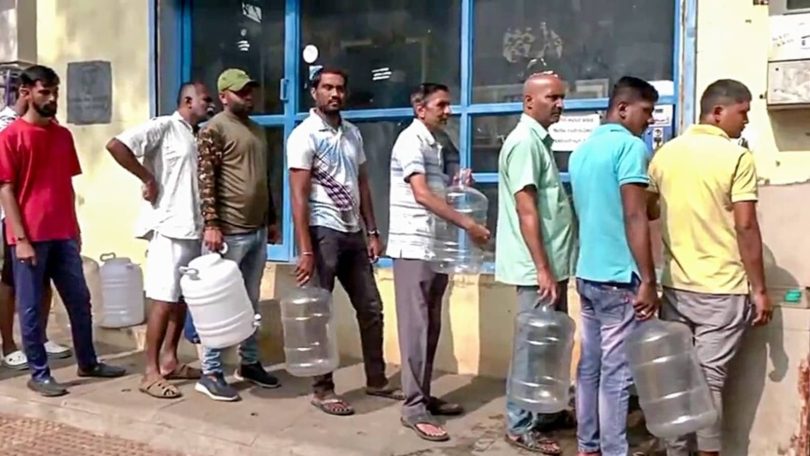[ad_1]
India’s Silicon Valley is grappling with one of its worst water crises just before the onset of summer. This appears to be paradoxical as a couple of years back the city woke up to boats being deployed after heavy rains lashed the IT capital and visuals of submerged villas and apartments went viral on social media. If it was the case of ‘water, water everywhere/ Nor any drop to drink’, it’s now all about the city going dry with water tankers increasingly becoming common sight.

The water crisis is a result of rapid urbanization, increase in construction activity, migration and the need to cater to the demands of the increasing population in the city.
Urban experts say that the main reason behind the water crisis is the mushrooming of borewells and lakes drying up. It should be noted that almost half of the city’s water demand is met by groundwater and the rest is serviced by the Cauvery river. Borewells have depleted, water bodies have been encroached upon and there has been poor enforcement of rainwater harvesting systems, they say. That’s not all – the Bengaluru Water Supply and Sewerage Board (BWSSB), the agency that provides drinking water to the tech capital, has reportedly not yet provided piped water supply to peripheral areas.
Water shortage has now spread to gated societies in Bengaluru as well. The cost of sourcing water from private tankers that was around ₹500 a few weeks back has now risen to almost ₹800-2,000 for a 12,000-liter tanker.
Also Read: Bengaluru ranks 8th and Mumbai 9th in annual housing price growth index across Asia Pacific region
Srikanth Viswanathan, Chief Executive officer, Janaagraha, is of the opinion that BWSSB needs to be strengthened significantly in terms of capabilities and finances, and be made more accountable for water and sanitation in the city.
“Bengaluru is a victim of piecemeal governance when it needs whole system governance. Instead of band aids and patchwork arising out of reactive governance, Bengaluru needs robust city systems and empowered but accountable city institutions which are proactive,” he adds.
Also Read: Bengaluru apartment’s ‘no water’ alert to residents amid ongoing crisis
Experts say that the city needs to work towards removing encroachments on water bodies; impose penalties for those not adhering to rainwater harvesting rules and last but not the least reuse sewage water.
Traffic woes
According to a Dutch geolocation technology firm TomTom, Bengaluru remained the most congested city in India in 2023 even as it dropped to sixth place globally. In 2022, Bengaluru was the second-most congested city globally, only behind London. In its 13th traffic index in 2023, TomTom found that the average time it took to travel 10 kilometres in Bengaluru’s city centre improved by a minute: in 2022, it took a commuter 29 minutes and 10 seconds, while in 2023, it was 28 minutes and 10 seconds.
Also Read: Surviving Bengaluru: 5 things to know before renting an apartment in the garden city
Viswanathan says that large cities need to take up preparation, implementation and enforcement of their spatial plans as the highest priority. Today 39% of state capitals in India don’t have updated master plans. “We also need to focus on the 15/20 minute neighborhood concept through mixed use neighborhoods. Congestion certainly has an impact on where people choose to live and work, city wise and neighborhood wise. An IIM Bengaluru study on Tender SURE roads revealed a higher property yield on them. Tender SURE roads address congestion through walkable footpaths and uniform travel lanes. Street design is yet another critical enabler of decongestion through both smoother traffic flow and facilitating practical use of public transport,” he explained.
Premium FAR
Karnataka Town and Country Planning (Amendment) Bill that was passed recently by the state government permits real estate developers to purchase additional `premium FAR’ by paying 40 percent of the guidance value in the area. However, the premium FAR may not exceed 60 percent of the permissible limit. That is, one can develop a maximum 60 percent more area than otherwise permitted for a plot (on payment of a premium).
Also Read: Karnataka Legislative Council passes FAR Amendment Bill amid boycott by BJP
This means that a developer can build more floors by paying a certain amount to the government as premium. The finer details of the Bill are not yet available.
Piloting the Bill, Deputy Chief Minister DK Shivakumar, who is also the minister for Bengaluru City Development, had said that premium FAR is already being provided in Mangaluru and that the government required the money for development. “What we are trying to do is to get money for development of major infrastructure. In Mangaluru, we’ve collected ₹2,000 crore over the past few years. In Bengaluru, up to two-thirds of the permissible FAR will be allowed as premium,” he was quoted by media reports as saying.
Premium FAR, say urban experts, may be a source of revenue generation as it allows developers to build more floors after paying a certain amount, it will put pressure on the already creaky infrastructure of the city. In densely populated areas that are not connected by the Metro, this measure may add to traffic congestion.
“If developers were to utilize this premium for projects located in core areas, it may not only increase traffic problems in that area but also put pressure on water and electricity supply on account of increase in density,” says Sarang Kulkarni, Managing director for a real estate advisory firm Descon Ventures Real Estate Services Pvt Ltd.
“If premium FSI is introduced, it should be a small part of a larger plan that takes into account infrastructure, water supply and mobility issues. A master plan should be in place to cater to the additional density,” he adds.
[ad_2]
Source link








